






Biographical Sketches
|
JIMMY CARTER Thirty-Ninth President • 1977-1981 |
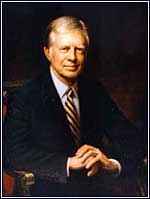 Jimmy Carter | |
| ||
Born in 1924 at Plains, Ga., James Earl ("Jimmy") Carter, Jr., was the first child of a farmer-storekeeper and a registered nurse-housewife. They later raised another son and two daughters. When Jimmy was 4 years old, the family moved to nearby Archery. He helped his father, who was also active in local and county affairs, on the farm and in the store.
Carter attended the local public school, which was in Plains. There, one of his teachers, Miss Julia Coleman, whom he quoted in his Presidential inaugural address, inspired him in intellectual and cultural endeavors. He graduated from high school in 1941.
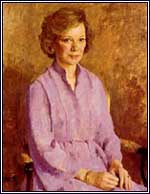 Rosalynn Carter |
After a year of study at Georgia Southwestern College in nearby Americus, Carter entered the Georgia Institute of Technology ("Georgia Tech") at Atlanta in 1942 as a naval ROTC student. The next year, he fulfilled a childhood ambition by entering the U.S. Naval Academy, in Annapolis, Md. His class, in which he stood in the top tenth, graduated in 1946 on an accelerated schedule because of the exigencies of World War II (1939-45). Shortly after graduation, he married Rosalynn Smith of Plains. They have four children—three sons and a daughter.
During Carter's subsequent naval career (1946-53), he rose from ensign to lieutenant. His wife accompanied him to his home ports. These included Norfolk, Va.; New London, Conn.; Pearl Harbor, Hawaii; San Diego, Calif.; and Schenectady, N.Y. He first served at sea on board experimental radar and gunnery vessels as well as submarines. The highlight of his service was participation in the nuclear submarine construction program, which was directed by Capt. (later Adm.) Hyman G. Rickover. During this time, Carter took courses in nuclear physics and reactor technology at Union College, Schenectady, N.Y.
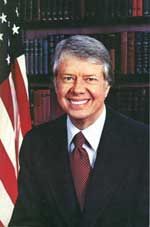 |
| Jimmy Carter. (Photograph, 1977, by Karl Schumacher.) |
In 1953, following the death of his father, who among his other activities had been sitting in the State legislature, Carter resigned his commission. He and his family returned to Plains and took over his father's farm and agricultural supply business. After some lean years, they built up a prosperous peanut production and processing enterprise.
Although Carter also involved himself in civic, church, and fraternal affairs, he steadfastly refused to join the local segregationist White Citizens' Council. He served on the county school, library, and hospital boards; and participated in local and State economic planning organizations.
In 1962 Carter, a lifelong Democrat, entered the political arena. After a strenuous contest, he won a seat in the State senate and held it for two terms (1963-67). He demonstrated a special interest in election reform and improvement of the educational system.
Carter had planned to run for the U.S. House of Representatives in 1966, but decided to seek the governorship after the leading candidate in his party withdrew. Although he failed to win the nomination then, he did so 4 years later, and then won the general election.
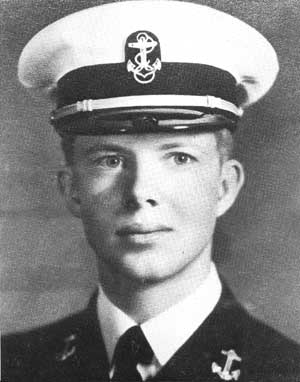 |
| Midshipman Carter in 1946, shortly before his graduation from the United States Naval Academy. (National Park Service, Special Collection, 1946.) |
During his single term (1971-75), while stressing economy and tightening budget procedures, Carter thoroughly reorganized the State government. He also displayed strong interest in conservation and attracted national attention for his moderate stance on civil rights. He capped his gubernatorial years by helping direct the 1974 Democratic national campaign.
Late that year, Carter announced his candidacy for the Presidency. In succeeding months, he, his family, and other backers crisscrossed the country to build up grassroots strength. After his success in Iowa's Democratic caucuses early in 1976, he won victories in several key primary elections. His phenomenal rise confounded political experts, who had regarded his quest as hopeless.
Carter's support mounted so steadily that several other leading contenders withdrew. Even before the convention, he gained virtual assurance of the nomination and, in a departure from tradition, announced in advance his Vice-Presidential choice, Senator Walter F. Mondale of Minnesota.
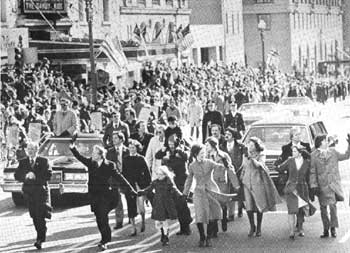 |
| Departing from tradition, Carter walked from the Capitol to the White House following his inauguration. Members of his family accompanied him. (National Park Service, Special Collection, 1977.) |
The contest between Carter and incumbent Chief Executive Ford, the first Presidential campaign conducted with substantial amounts of public funds, featured a series of three televised debates sponsored by the League of Women Voters. These were the first since those in 1960, but the television debate between Vice-Presidential candidates Mondale and Republican Senator Robert J. Dole set a precedent.
Carter won by a relatively narrow but conclusive margin over Ford in both popular and electoral votes—the popular margin exceeding that of Kennedy in 1960 and Nixon in 1968. Carter scored heavily among blacks and with labor, showed special strength in his native South, and ran well in the Northeast. He was the first President from Georgia and the first elected directly from the Deep South since Zachary Taylor in 1848.
| HISTORIC SITES & BUILDINGS |
 Jimmy Carter National Historic Site Carter Presidential LIbrary |
Following his triumph, President-elect Carter vacationed at St. Simons Island, Ga. From there and his home in Plains, though he made a few trips to Washington, he directed preparations for the assumption of power. In naming his Cabinet, he stated that he planned to emphasize its role in Government. The transition, which enjoyed the full cooperation of Ford, was conducted smoothly and amicably.
Dramatizing his intention to remain close to the people and to disavow many of the trappings of the Presidency, after his inauguration at the Capitol Carter broke with custom and walked down Pennsylvania Avenue to the White House.
As Carter took office, he stressed his plans to stimulate the economy, reduce unemployment, attack inflation, balance the Federal budget, reorganize the executive branch, formulate a comprehensive energy program, and further racial and social justice. In foreign policy, he set as his guideposts the maintenance of global peace, reduction of armaments, demonstration of concern for human rights, and the enhancement of relations with all nations.
 |
 |
http://www.cr.nps.gov/history/online_books/presidents/bio39.htm
Last Updated: 22-Jan-2004